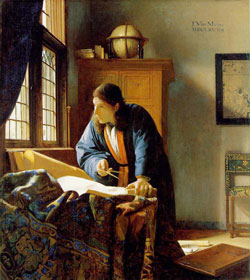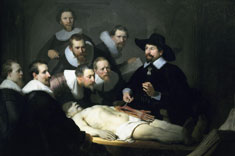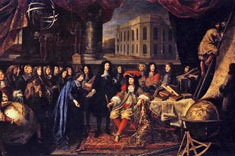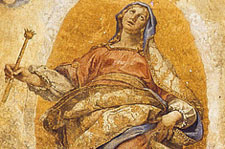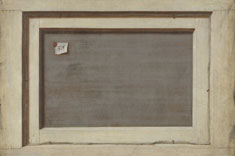
The Scientific Revolution and the Baroque
While deviations from Aristotle’s teachings were often seen as an attack on the church in the 1500s, during the 1600s studies of nature, like the new astronomy of Brahe, Copernicus, and Galileo, began to be seen as a celebration of God’s creation.
In step with the changing relationship between science and the church, one could gradually discuss pictures of the universe more openly. From this angle, the Scientific Revolution, which laid the foundation for modern science, began around 1600. This was not just a case of a few visionary scientists who challenged existing ideas about the organisation of nature. It was a fundamental change in the way to study nature, with systematic experiments, documentation of results, and the use of mathematics to describe the workings of the physical world. The evolution of this change can also be traced by the emergence of the microscope, telescope, barometer and the thermometer, which were all invented in the 1600s.
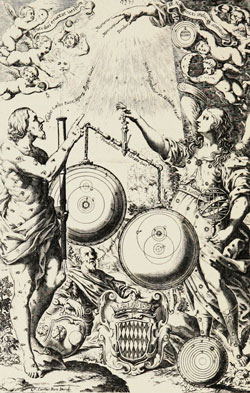
This engraving was the front page of the astronomer and priest Riccioli’s work Almagestum novum (1651). The picture shows Urania, the goddess of the heavens weighing the Copernican and Riccioli’s version of the Tychonian world view against each other - Riccioli’s adaptation of Tycho Brahe’s system is the weightiest. The man whose body is covered with eyes is the 100-eyed giant Argus Panoptes from Greek mythology, who represents the night sky and empirical science. Uppermost is the hand of God, from which numbers, words and the scale emanate. The discussion of the new world views are thus put into a Christian context.
Geography and astronomy
The 1600s saw many changes in geography and astronomy. Not only was the existing world map extended to encompass new lands, but also the Earth’s relation to and distance from other celestial bodies were challenged. This battle over the world view can be seen in pictures like those on the engraving below, which shows three models of the universe. To the left is the Copernican view, with the Sun in the centre. To the right is the astronomer and priest Riccioli’s (1598-1671) version of Tycho Brahe’s (1546-1601) model.
According to Tycho, the Sun and the Moon orbited the Earth, and Mercury, Venus, Mars, Jupiter, and Saturn revolved around the Sun. In Riccioli’s adaptation of Tycho’s system Jupiter and Saturn orbit the Earth. The man pictured below is the Greek astronomer, mathematician and geographer Ptolemy (ca. 100-ca. 170), whose geocentric world view is rejected and lies at the feet of Urania.
The new and old science with Vermeer
With the Dutch painter Jan Vermeer van Delft, also known as Johannes Vermeer (1632-1675), one can say that these major upheavals are treated with a quieter drama than in the engraving above. In the closely related paintings The Astronomer and The Geographer the shadow effects and draperies create movement and the theme deals with nothing less than the world view of the age. Yet there is also a peace in the pictures - you see two natural philosophers (the old word for scientists), each absorbed in their studies.
The Astronomer
The Astronomer shows several objects that were popular in astronomical circles in the Netherlands. Half hidden by the draped fabric is an astrolabe - an instrument that could determine the distance of celestial bodies from the horizon line. The book that lies open before the scientist, Institutiones Astronomicae Geographicae, is by the Dutch astronomer and mathematician Adriaan Metius (1571-1635), who worked for Tycho Brahe on the Island of Ven. The book is a reference book in astronomy and geography, which were closely related in the 1600s, and it is open to the section that advises the natural philosopher to seek inspiration from God.
The astronomer leans forward to turn a celestial globe - a globe that shows the positions of stars and constellations. On the wall is seen half of a picture depicting Moses, who was thought to be the oldest geographer, because he led the Israelites through the desert. According the Bible, Moses had learned everything the Egyptians knew, and the Egyptian knowledge of astronomy was far from insignificant. In The Astronomer Moses represents a kind of science that draws upon ancient wisdom rather than making use of observations from measuring instruments. In this way, one can say that The Astronomer simultaneously shows ‘the old’ and the ‘the new’ science, because Vermeer also includes scientific technology of the age in the painting.
The Geographer
In The Geographer, the natural philosopher is standing ready with his compass aimed towards the map, but at the same time is looking thoughtfully out the window. The picture shows the basic principle of the geographer’s work process:He looks at the earth, measures with his instruments and records his observations on the map. The geographer is wearing a silk robe that was popular among that period’s academics. The silk robe is Asian-inspired and perhaps the oriental blanket on the table points to the significance of Dutch trade with the Far East. Blue often symbolises truth and perhaps refers here to the natural philosopher’s intellectual quest.
The astronomer looks out at the universe, and the geographer looks at the Earth on his map with a bird’s-eye view. The Astronomer and The Geographer illustrate two of the most groundbreaking movements in the replacement of the earth-centered, Aristotelian view with a perspective based on science - part of the foundation for the world view we have today. The Astronomer and The Geographer illustrate in that way two of the most groundbreaking movements in relation to the contemporary world view - part of the foundation for the world view we have today.
The scientific gaze with Chardin
The same can be said about Jean-Baptiste Siméon Chardin’s (1699-1779) Attributs des Sciences (eng. The Attributes of the Sciences) from 1731.
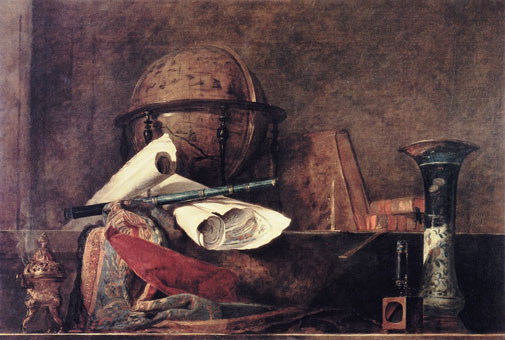
The artist Chardin stood out among contemporary French painters, who were often oriented toward sensual pleasure. Chardin drew his inspiration from the more reflective and morally charged Dutch and Flemish Baroque art.
Seen in The Attributes of the Sciences are a globe, a telescope, a microscope, books and maps. The painting also includes the microscopic as well as macroscopic gaze, and the and the maps, globes and books represent the documentation and dissemination of knowledge. The picture is what is called a still life, which has arrangements of inanimate objects as the motif. Because no people are seen in the picture, the instruments used for observing nature are placed in the centre - in that way the work shows the scientific gaze. The Attributes of the Sciences can thus be seen as a reflection of the scientific revolution and the new world view that was gradually being accepted in Chardin’s time.
| << Previous | Next >> |
The Baroque
|
Scientific societies
|
A salute to Galileo
|


